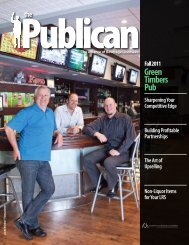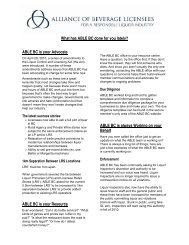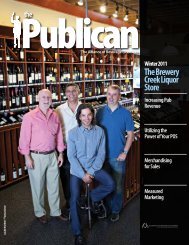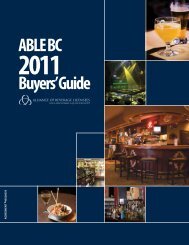The Spike Pub & Liquor Store - ABLE BC
The Spike Pub & Liquor Store - ABLE BC
The Spike Pub & Liquor Store - ABLE BC
You also want an ePaper? Increase the reach of your titles
YUMPU automatically turns print PDFs into web optimized ePapers that Google loves.
Controlling food cost has never been so important nor so difficult for pub<br />
operators. In the changing competitive landscape, the future success of pubs<br />
depends on their ability to capitalize on the opportunities available from new<br />
operating models. One key opportunity rests in the increased prominence of<br />
food programs.<br />
<strong>The</strong> pub industry has been hit hard recently. After overcoming challenges<br />
presented by legislation related to smoking and alcohol service, the last couple<br />
of years have brought a second wave of trials that jeopardized this industry's<br />
survival. <strong>The</strong> economic downturn reduced the disposable income of consumers<br />
and decreased their spending in food service operations. Increased wage<br />
demands and higher input prices have reduced operators' margins. Now, as<br />
<strong>BC</strong> adopts the HST, patrons will pay tax on items that were previously exempt,<br />
which will likely reduce spending further.<br />
In order to thrive, not just survive, operators must rely less on alcohol sales and<br />
begin diversifying their service offerings. Food can no longer be an afterthought.<br />
A greater focus on food programs will increase revenues, build traffic flows,<br />
and improve profitability. Unlike alcohol, food menus provide operators with<br />
the ability to differentiate themselves from the competition and can become<br />
a more stable source of long-term growth.<br />
Benefiting from these opportunities, however, requires a different approach to<br />
menu planning and cost control. Recipes will become increasingly complex,<br />
menus will need to be updated more often, and there will need to be a greater<br />
emphasis on fresh, made-from-scratch dishes. In light of these changes,<br />
managers should consider the following practical suggestions to ensure that<br />
food costs are maintained and their financial targets are achieved:<br />
Standardize Recipes<br />
Detailed recipes and product specifications will need to be created and adhered<br />
to. <strong>The</strong>se standards will guide employee food production, guarantee that guests<br />
receive a consistent product, and ensure that item costs can be maintained.<br />
Batch recipe and yield costs must also be developed as the number of items<br />
made on site increases.<br />
Update Menu Costing<br />
Every food product and processing activity has a certain amount of inherent<br />
natural variation that cannot be controlled. Not every head of romaine is exactly<br />
the same, for example, and not every roast shrinks the same amount when<br />
cooked. As more fresh ingredients are utilized and the number of preparation<br />
steps increase, the greater the impact of this variation will have on food costs.<br />
Management must include an allowance for this variation when they determine<br />
costs for each menu item. Not doing so will result in ideal cost targets being<br />
set that could never be met, and prices being set that do not provide adequate<br />
margins.<br />
Multiple Vendor Sourcing<br />
Unless contract prices are established, fresh and locally sourced ingredients<br />
are prone to more frequent price changes. To protect themselves, operators<br />
should ensure that they have a minimum of two suppliers for every product<br />
they use. Not only will this promote price competition between vendors, it<br />
will also reduce the chance that the pub will get caught shorthanded, should<br />
a vendor have problems with its supply.<br />
Improve Receiving Practices<br />
Many management hours are spent trying to correct supply problems such<br />
as short shipments, product substitutions, and inferior quality product, which<br />
could have been caught at the door. With clear specifications established, staff<br />
entrusted with receiving product should inspect all items to ensure that they<br />
meet the pub's requirements. Often this involves little more than checking<br />
items off of the delivery invoice.<br />
A scale should be located near the receiving area so that staff can verify the<br />
weight of arriving products. It should be used for items purchased by weight,<br />
such as beef as well as for checking the weight of a case of tomatoes or potatoes.<br />
All produce should be inspected for quality as well as size specifications.<br />
Occasionally, cases should be opened from the bottom to verify that the<br />
<strong>The</strong> <strong>Pub</strong>lican<br />
23









